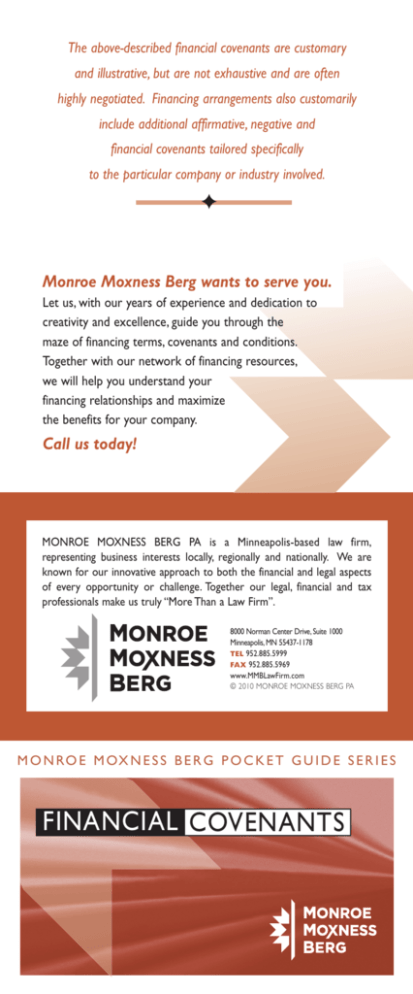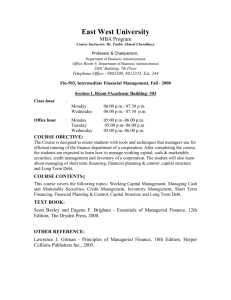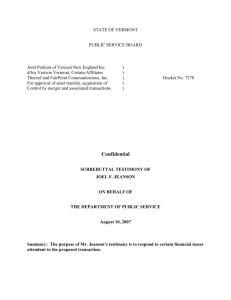financial covenants - Monroe Moxness Berg
advertisement

The above-described financial covenants are customary and illustrative, but are not exhaustive and are often highly negotiated. Financing arrangements also customarily include additional affirmative, negative and financial covenants tailored specifically to the particular company or industry involved. ✦ Monroe Moxness Berg wants to serve you. Let us, with our years of experience and dedication to creativity and excellence, guide you through the maze of financing terms, covenants and conditions. Together with our network of financing resources, we will help you understand your financing relationships and maximize the benefits for your company. Call us today! MONROE MOXNESS BERG PA is a Minneapolis-based law firm, representing business interests locally, regionally and nationally. We are known for our innovative approach to both the financial and legal aspects of every opportunity or challenge. Together our legal, financial and tax professionals make us truly “More Than a Law Firm”. 8000 Norman Center Drive, Suite 1000 Minneapolis, MN 55437-1178 TEL 952.885.5999 FAX 952.885.5969 www.MMBLawFirm.com © 2010 MONROE MOXNESS BERG PA M O N RO E M OX N E S S B E R G P O C K E T G U I D E S E R I E S FINANCIAL COVENANTS A PRIMER ON CUSTOMARY FINANCIAL COVENANTS FOR SENIOR DEBT, SUBORDINATED DEBT AND MEZZANINE FINANCING ARRANGEMENTS Premise: Lenders and investors desire to minimize their risk without controlling day to day management of the company. Therefore, financing arrangements customarily include one or more financial covenants to enable the lender or investor to monitor the financial performance of the company on a periodic basis. Some customary financial covenants include the following: Pre-Compensation FCCR Post-Compensation FCCR Funded Debt/ EBITDA Effective Funded Debt to EBITDAR Current Ratio Net Income PRE-COMPENSATION FIXED CHARGE COVERAGE RATIO (Cash Flow) This ratio measures a company’s cash flow cushion and ability to pay its debt service and other fixed expenses, by comparing its Pre-Compensation Cash Flow (typically EBITDA minus any non-recurring income items) to its Fixed Charges (typically current portion of long term debt and capitalized leases, interest expense and third-party rent). Pre-Compensation FCCR is expressed as a minimum ratio (for example, 1.3 to 1.0). This means that the company’s Pre-Compensation Cash Flow must equal or exceed 1.3 times its Fixed Charges, typically measured quarterly on a rolling twelve month basis, in order to provide an acceptable cash flow cushion. POST-COMPENSATION FIXED CHARGE COVERAGE RATIO (Cash Flow) This ratio is similar to Pre-Compensation FCCR, but measures a company’s cash flow cushion and ability to pay its debt service and other fixed expenses, by comparing its Post-Compensation Cash Flow (typically EBITDA minus any non-recurring income items and minus dividends, distributions, loan payments and other non-expensed compensation paid to owners and affiliates) to its Fixed Charges (typically current portion of long term debt and capitalized leases, interest expense and third-party rent). This ratio is generally used as a restriction on dividends and other forms of owner compensation. Post-Compensation FCCR is also expressed as a minimum ratio (for example, 1.1 to 1.0). This means that the company’s Post-Compensation Cash Flow must equal or exceed 1.1 times its Fixed Charges, typically measured quarterly on a rolling twelve month basis, in order to provide an acceptable cash flow cushion after owner’s compensation. FUNDED DEBT TO EBITDA (Leverage) This ratio measures the amount of a company’s leverage, by comparing its Funded Debt (typically obligations for borrowed money, deferred purchase price of assets and capitalized leases) to the company’s EBITDA (earnings before interest, taxes, depreciation and amortization). Funded Debt to EBITDA is expressed as a maximum ratio (for example, 3.5 to 1.0). This means that the company’s Funded Debt may not exceed 3.5 times its EBITDA, typically measured quarterly on a rolling twelve month basis, in order to ensure an acceptable level of leverage. EFFECTIVE FUNDED DEBT TO EBITDAR (Effective Leverage) This ratio measures the amount of a company’s leverage, by comparing its Effective Funded Debt (typically obligations for borrowed money, deferred purchase price of assets, capitalized leases and an amount equal to annual rent on operating leases multiplied by 8) to the company’s EBITDAR (EBITDA plus annual rent). It is expressed as a maximum ratio (for example, 5.0 to 1.0). This means that the company’s Effective Funded Debt may not exceed 5.0 times its EBITDAR, typically measured quarterly on a rolling twelve month basis, in order to ensure an acceptable level of leverage, including rental obligations. CURRENT RATIO (Liquidity) This ratio measures a company’s liquidity, by comparing its Current Assets (typically cash, non-related party accounts receivable and other current assets under GAAP) to its Current Liabilities (typically current liabilities under GAAP, excluding related party payables and current portion of long term debt and capitalized leases). Current Ratio is expressed as a minimum ratio (for example, 1.0 to 1.0). This means that the company’s Current Assets must equal or exceed its Current Liabilities, typically measured as of the last day of each fiscal or calendar quarter, in order to provide an acceptable level of liquidity. NET INCOME (Profitability) This covenant requires a company to maintain a certain level of Net Income, expressed as a minimum dollar amount (for example, $500,000). Net Income is typically measured on an annual basis at the end of the company’s fiscal year, and the covenant requirement may be as low as one dollar, simply to require that the company not show a net loss for the year.









